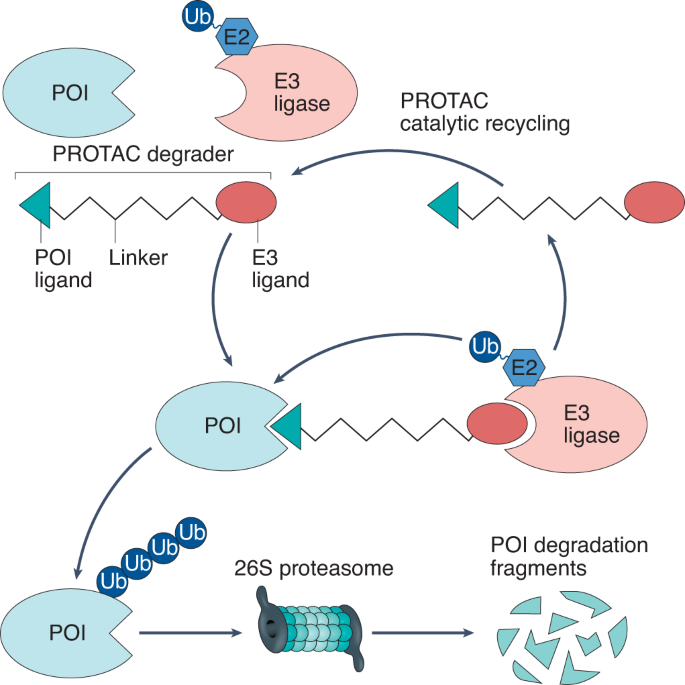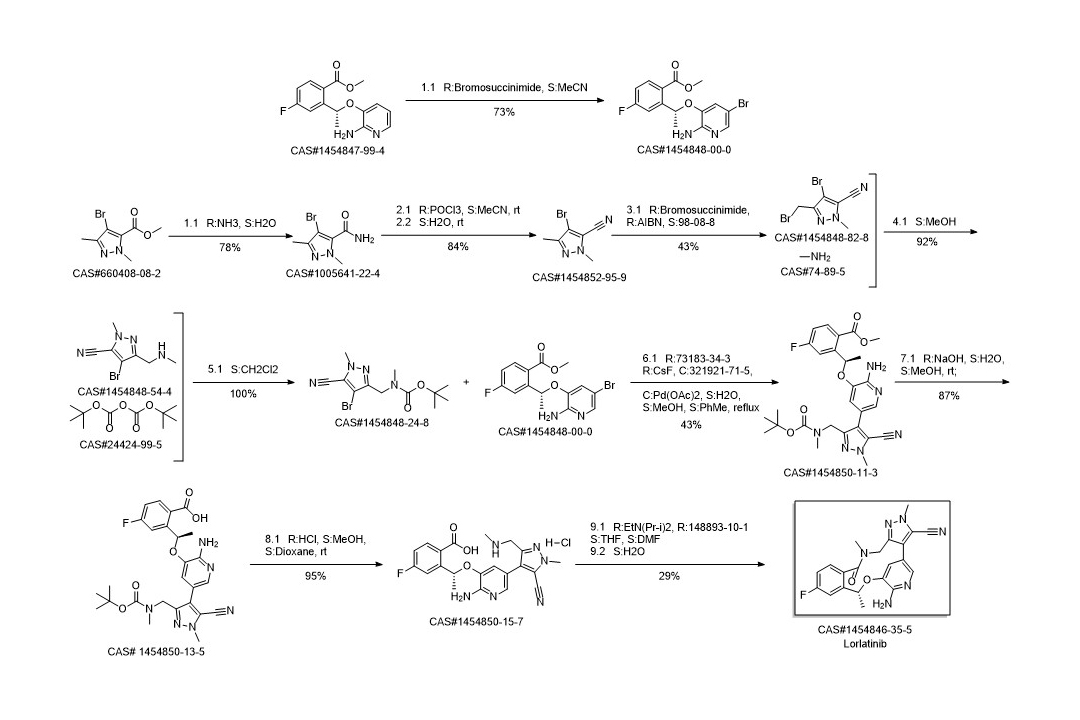Proteolysis targeting chimeric (PROTAC) technology is a recently discovered technique that has profound efficacy in cancer. This approach was first established in 2001. It is based on a ubiquitin-proteasome system that works to degrade target proteins via ubiquitination, thus suppressing the growth of tumors. Many kinds of research and clinical trials have been performed recently to determine the effect and feasibility of PROTAC technology in degrading endogenous proteins that have shown promising results. One of the most promising and encouraging results was found in oral PROTAC therapy in breast cancer and prostate cancer treatment. (1)
Mechanism of Action of PROTAC:
Different physiological and pathophysiological mechanisms work in our body for the degradation of proteins, including cell cycle control, gene transcription, apoptosis, etc. Among all these systems, PROTAC technology uses a ubiquitin-proteasome system (UPS) for the targeted degradation of protein in different cancerous and tumor cells. UPS depends on ATP for its activity and has two ordered steps, including:
- Polyubiquitination of the target protein
- Proteolysis of polyubiquitin by 26S proteolytic enzyme complex
PROTAC molecules attach E3 ligases to a target protein that initiate the degradation process by ubiquitination of target proteins by E3 ligases. Proteasome (26S) then degrades this ubiquitinated protein, and the activity of PROTACs is not dependent upon the kinase activity of target proteins. (2)
Effects of PROTAC During the Course of Cancer Causation:
Initiation and progression of cancer is a complex process, including different pathophysiological changes in the cells, including proliferative signaling, inhibiting growth suppression, induction of angiogenesis, countering cell death, and activation and local invasion and distant metastasis. Evidence-based research and clinical trials have explained the crucial role of overactivated and overexpressed proteins in the initiation and progression of cancer. These proteins are the focus of most of the therapeutic approaches used for the treatment and abolishment of cancer and different associated factors. (3) Here, we will précis about the PROTAC approach in cancer therapy.
Cancer Cell Proliferation:
PROTAC technology targets proteins that are hyperactivated or mutated and result in cell cycle progression that favors cancer cell proliferation. One main pathway of cell cycle regulation that is hyperactivated in proliferating cancer cells is the RAS-RAF-MEK-ERK pathway. Proteins act as inhibitors or accelerators for regulating the cell cycle by controlling CDK expressions. CDKs and their chaperones release transcription factor E2F by phosphorylation of retinoblastoma protein resulting in DNA replication. Growth signaling and progression also depend upon the RAS-RAF-MEK-ERK pathway, which plays a key role. Until now, PROTACs have been developed that target oncogenic proteins including BRD4, EGFR, CDK4/6, AURORA-A, CDK2/5, MEK1/2, HER, etc. (4)
Cancer Apoptosis:
Apoptosis is the programmed death of the cells that helps to maintain tissue hemostasis during DNA damage, immune surveillance, and cellular stress. In cancerous cells, proteins favoring cell death are downregulated, and those inducing cell survival are upregulated. It increases cell survival, resistance to endogenous and exogenous apoptotic factors, and cancer causation and recurrence. PROTACs target proteins that regulate apoptosis, thus improving the effects of anticancer factors and increasing the programmed death of the cells. Downregulation of antiapoptotic proteins, including Bcl-2, Bcl-xL, Bcl-6, and Mcl-1, and upregulation of proapoptotic proteins, including Bax and Puma, by PROTACs make them a better therapeutic choice for the treatment of different types of cancers. (5)
Cancer Angiogenesis:
Tumor cells require neurovascular supplies to get nutrients and excrete waste products essential for their growth and proliferation. Angiogenesis depends upon various factors, including VEGF (a principal factor), whose expressions are activated by hypoxia resulting in the induction of angiogenesis. PROTAC technology can target these growth factors that can result in the suppression of angiogenesis and proliferation of cancer cells. Growth factors that are the targets of PROTACs in the inhibition of angiogenesis include VEGFR2, PI3K, CBP/p300, etc. (6)
Cancer Immunity and Inflammation:
Tumor cells involve activated signaling of different regulatory cells, including T-cell receptor (TCR) and B-cell receptor (BCR), that cause reprogramming of cancerous microenvironment leading to immune evasion and inflammation. These processes are essential for tumor cell survival. Immunotherapies have significant roles in enabling immune-meditated clearance of cancer cells. However, some patients have resistance to these therapies. PROTACs can target the proteins that carry out different pathways, such as TCR, BCR, and JAK-STAT pathways. They have evidence-based activity against BTK, PD-L1, STAT3, ITK, JAK, etc., which are essential in carrying out TCR, BCR, and JAK-STAT pathways. (4)
Cancer Metastasis:
Cancerous cells can successfully disseminate and travel via blood or lymphatic circulation and colonize distant organs away from their primary site of occurrence. This process is called metastasis which is responsible for approximately 90% of cell deaths worldwide. Metastasis requires a key step called Epithelial-to-mesenchymal transition, which is dependent upon different cellular signaling pathways, including Integrin/FAK/PI3K/AKT axis. PROTACs have been developed in past few years to target proteins related to Epithelial-to-mesenchymal transition. The key pathways involved in increased expression of Epithelial-to-mesenchymal transition include Integrin/FAK/PI3K/AKT, Wnt/β-catenin, and TGF-β/SMAD. PROTACs can target proteins involved in the regulation of these pathways, such as FAK, Smad3, p38, IGF-IR, TCF, etc. (3)
Conclusion:
In the bottom line, PROTAC technology has extensively progressed from its start in 2001, with significant efficacy in improving cancer treatments. However, there is still a need to have more clinical trials and evidence-based research on its efficacy. The effects of PROTACs in controlling cancer progression and its counterattacking mechanisms during different steps of cancer cell growth, proliferation, and spread have been studied. However, developing different types of PROTACs with specific advantages and overcoming disadvantages and therapeutic efficacy and safety need more study.
References:
- Xie H, Liu J, Alem Glison DM, Fleming JB. The clinical advances of proteolysis targeting chimeras in oncology. Explor Target Antitumor Ther. 2021;2(6):511–21.
- Qi SM, Dong J, Xu ZY, Cheng XD, Zhang WD, Qin JJ. PROTAC: An Effective Targeted Protein Degradation Strategy for Cancer Therapy. Front Pharmacol. 2021 May 7;12.
- Wang C, Zhang Y, Zhang T, Shi L, Geng Z, Xing D. Proteolysis-targeting chimaeras (PROTACs) as pharmacological tools and therapeutic agents: advances and future challenges. J Enzyme Inhib Med Chem. 2022 Dec;37(1):1667–93.
- Li X, Song Y. Proteolysis-targeting chimera (PROTAC) for targeted protein degradation and cancer therapy. J Hematol Oncol. 2020;13(1):50.
- Li X, Pu W, Zheng Q, Ai M, Chen S, Peng Y. Proteolysis-targeting chimeras (PROTACs) in cancer therapy. Mol Cancer. 2022;21(1):99.
- Ocaña A, Pandiella A. Proteolysis targeting chimeras (PROTACs) in cancer therapy. J Exp Clin Cancer Res. 2020 Sep 15;39(1):189.






